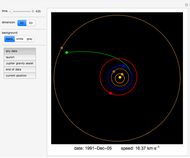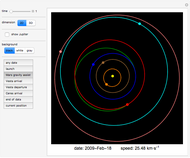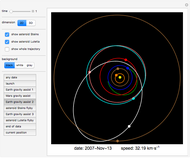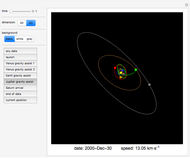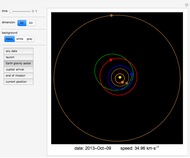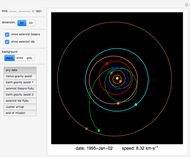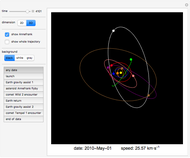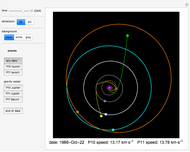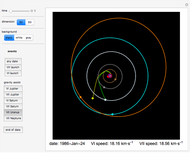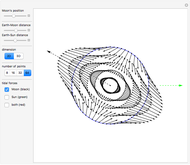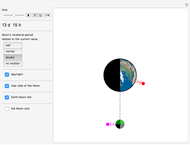EPOXI

Requires a Wolfram Notebook System
Interact on desktop, mobile and cloud with the free Wolfram Player or other Wolfram Language products.
This Demonstration shows an animation of the flight of the EPOXI spacecraft's mission to two comets (9P/Tempel 1 and 103P/Hartley 2). This spacecraft used a technique called gravitational assist three times with the Earth (December 31, 2007; December 30, 2008 and June 27, 2010). Closest approach to comet Tempel 1 occured on July 04, 2005 and closest approach to comet Hartley 2 occured on November 04, 2010.
[more]
Contributed by: Tomas Franc (August 2013)
Open content licensed under CC BY-NC-SA
Snapshots
Details
The time step is one day, positions are at midnight, and the speed is measured relative to the Sun. The origin is at the Sun with the positive  axis pointing toward the vernal equinox.
axis pointing toward the vernal equinox.
Nothing here is modeled; all positions of the spacecraft and planets were obtained from NASA JPL. We thank NASA JPL for providing the data.
The values at dates 2005-Jul-04 and 2005-Jul-05 were added manually with respect to values at adjacent days—these values were not available.
Information about the mission can be found on NASA's Deep Impact website and on NASA's EPOXI website.
More information about the gravitational assist can be found in [1]. A manual on how to create such an animation can be found in [2]. For more information, see the author's website.
References
[1] T. Franc, "The Gravitational Assist," in Week of Doctoral Students 2011—Proceedings of Contributed Papers: Part III—Physics (WDS 2011), Prague (J. Safrankova and J. Pavlu, eds.), Prague: MatfyzPress Publishing House, 2011 pp. 55–60. www.mff.cuni.cz/veda/konference/wds/proc/pdf11/WDS11_309_f12 _Franc.pdf.
[2] T. Franc, "Gravitational Assisted Trajectories—Making Your Own Pictures and Trajectory Study," in Proceedings GIREP-EPEC Conference 2011, Physics Alive, Jyväskylä, Finland (A. Lindell, A. Kähkönen, and J. Viiri, eds.), Jyväskylä, Finland: University of Jyväskylä, 2011 pp. 202–207. www.jyu.fi/en/congress/girep2011/main-page/electronic-proceedings-of-the-girep-epec-2011-conference.pdf.
Permanent Citation
"EPOXI"
http://demonstrations.wolfram.com/EPOXISpaceflight/
Wolfram Demonstrations Project
Published: August 20 2013






